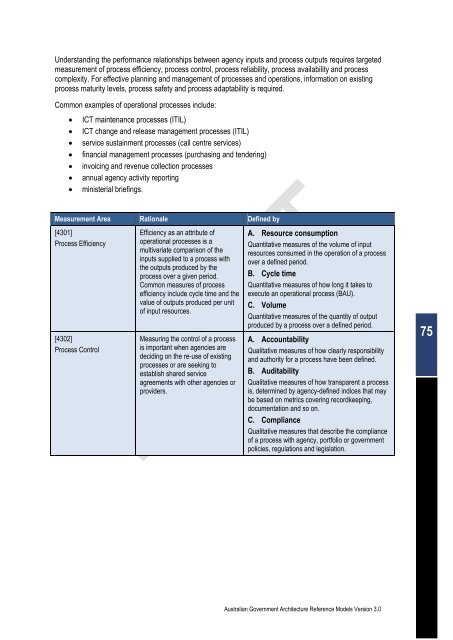Australian Government Architecture Reference Models Version 3.0
Australian Government Architecture Reference Models Version 3.0
Australian Government Architecture Reference Models Version 3.0
You also want an ePaper? Increase the reach of your titles
YUMPU automatically turns print PDFs into web optimized ePapers that Google loves.
Understanding the performance relationships between agency inputs and process outputs requires targeted<br />
measurement of process efficiency, process control, process reliability, process availability and process<br />
complexity. For effective planning and management of processes and operations, information on existing<br />
process maturity levels, process safety and process adaptability is required.<br />
Common examples of operational processes include:<br />
� ICT maintenance processes (ITIL)<br />
� ICT change and release management processes (ITIL)<br />
� service sustainment processes (call centre services)<br />
� financial management processes (purchasing and tendering)<br />
� invoicing and revenue collection processes<br />
� annual agency activity reporting<br />
� ministerial briefings.<br />
Measurement Area Rationale Defined by<br />
[4301]<br />
Process Efficiency<br />
[4302]<br />
Process Control<br />
Efficiency as an attribute of<br />
operational processes is a<br />
multivariate comparison of the<br />
inputs supplied to a process with<br />
the outputs produced by the<br />
process over a given period.<br />
Common measures of process<br />
efficiency include cycle time and the<br />
value of outputs produced per unit<br />
of input resources.<br />
Measuring the control of a process<br />
is important when agencies are<br />
deciding on the re-use of existing<br />
processes or are seeking to<br />
establish shared service<br />
agreements with other agencies or<br />
providers.<br />
A. Resource consumption<br />
Quantitative measures of the volume of input<br />
resources consumed in the operation of a process<br />
over a defined period.<br />
B. Cycle time<br />
Quantitative measures of how long it takes to<br />
execute an operational process (BAU).<br />
C. Volume<br />
Quantitative measures of the quantity of output<br />
produced by a process over a defined period.<br />
A. Accountability<br />
Qualitative measures of how clearly responsibility<br />
and authority for a process have been defined.<br />
B. Auditability<br />
Qualitative measures of how transparent a process<br />
is, determined by agency-defined indices that may<br />
be based on metrics covering recordkeeping,<br />
documentation and so on.<br />
C. Compliance<br />
Qualitative measures that describe the compliance<br />
of a process with agency, portfolio or government<br />
policies, regulations and legislation.<br />
<strong>Australian</strong> <strong>Government</strong> <strong>Architecture</strong> <strong>Reference</strong> <strong>Models</strong> <strong>Version</strong> <strong>3.0</strong><br />
75

















